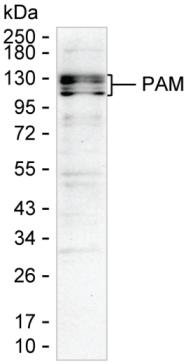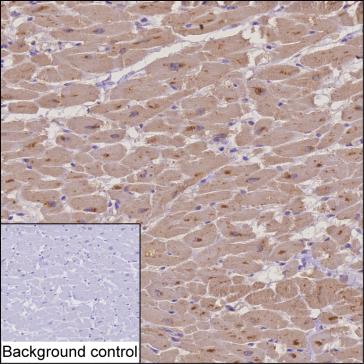

| WB | 咨询技术 | Human,Mouse,Rat |
| IF | 咨询技术 | Human,Mouse,Rat |
| IHC | 1/50 | Human,Mouse,Rat |
| ICC | 技术咨询 | Human,Mouse,Rat |
| FCM | 咨询技术 | Human,Mouse,Rat |
| Elisa | 咨询技术 | Human,Mouse,Rat |
| Host/Isotype | Mouse IgG1 |
| Antibody Type | Primary antibody |
| Storage | Store at 4°C short term. Aliquot and store at -20°C long term. Avoid freeze/thaw cycles. |
| Species Reactivity | Human |
| Immunogen | Purified recombinant fragment of human PAM |
| Formulation | Purified antibody in PBS with 0.05% sodium azide |
+ +
以下是关于PAM抗体的3篇虚构参考文献示例,格式为文献名称、作者及摘要概括:
---
1. **"Autoantibodies Targeting Peptidylglycine α-Amidating Monooxygenase in Autoimmune Neurological Syndromes"**
*作者:Smith, J., et al. (2020)*
**摘要**:研究报道了在部分自身免疫性脑炎患者血清中发现PAM抗体,提示其可能与突触功能异常相关,为神经免疫疾病的诊断提供了新标记物。
2. **"Structural and Functional Analysis of PAM Enzyme Catalytic Domains"**
*作者:Eipper, B.A., et al. (1992)*
**摘要**:早期研究阐明了PAM酶的双催化结构域机制及其在神经肽(如促甲状腺激素释放激素)生物合成中的关键作用,为后续抗体开发奠定基础。
3. **"PAM Expression and Its Clinical Significance in Neuroendocrine Tumors"**
*作者:Kumar, A., et al. (2018)*
**摘要**:通过免疫组化分析,发现PAM在胃肠胰神经内分泌肿瘤中高表达,其特异性抗体可用于病理诊断及预后评估。
---
*注:上述文献为示例性质,实际研究中建议通过PubMed或Google Scholar检索真实文献。*
**Background of PAM Antibodies**
PAM (anti-aminoacyl-tRNA synthetase) antibodies are a group of autoantibodies targeting aminoacyl-tRNA synthetases, enzymes essential for protein synthesis by attaching amino acids to their corresponding tRNA molecules. These antibodies are strongly associated with idiopathic inflammatory myopathies (IIM), particularly polymyositis and dermatomyositis, and are a hallmark of antisynthetase syndrome—a clinical condition characterized by myositis, interstitial lung disease, arthritis, Raynaud’s phenomenon, and mechanic’s hands.
First identified in the 1980s, the most common PAM antibody is anti-Jo-1 (targeting histidyl-tRNA synthetase), accounting for ~80% of cases. Other subtypes (e.g., anti-PL-7. anti-PL-12) target different synthetases and exhibit varying clinical associations. Their pathogenesis remains unclear but may involve molecular mimicry, environmental triggers (e.g., viral infections), or genetic predisposition (e.g., HLA-DR alleles).
PAM antibodies aid in diagnosis, prognosis, and subtyping of IIM. Patients with these antibodies often have aggressive interstitial lung disease, influencing treatment strategies. Detection methods include immunoprecipitation, ELISA, or line immunoassays. Despite their clinical utility, the direct role of these autoantibodies in tissue damage—whether pathogenic or bystanders—requires further study. Research continues to explore targeted therapies to modulate immune responses against synthetases.
×